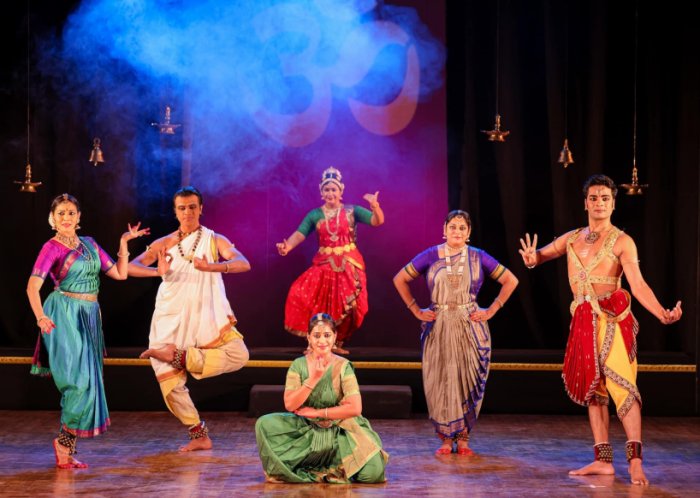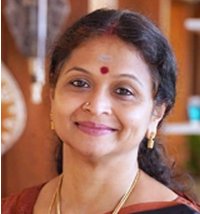
|   |

|   |
Adi Ashtakam in Bharatanatyam - Dr. Padmaja Suresh e-mail: padmajasuresh@hotmail.com Photo: Harshavardan K August 16, 2023 The proponent of Advaita Vedanta, Bhagavatpada Sri Adi Sankara who places Jnana Marga or the path of knowledge at the highest, has also composed numerous hymns and poetry on various deities, thus equally propagated the Bhakti Marga or the path of devotional surrender. His Ashtakams with eight stanzas are a treasure that are replete with profound meaning and aesthetic import. All the same, it is neither easy to compose the music nor thoroughly interpret with involvement when we have the Daiva Bhasha in hand. Classical dances since several years, have been evolving the 'Deshi' way as against the 'Margi', with dance pieces in spoken tongues very often. Sanskrit has been restricted to an opening invocation or another such hymn, with not much detailed exposition. Ganesha Pancharatnam, Shiva Panchakshari, Soundarya Lahiri, Bhaja Govindam, Ardhanareeshwarashtakam, Lingashtakam, Achyutashtakam are some of the Jagadguru's compositions, that have been attempted by many dancers. Hence the uniqueness of the program that included six Ashtakams by six chosen dancers - Adi Ashtakam that was staged on August 6th at ADA Rangamandira, Bangalore. These dancers make a league from among those who are emerging as well as reckoned in the years to come. The program was curated by well-known impresario Dr. Usha R.K who was also felicitated by the collaborator, Vaishnavi Natyashala led by Mithun Shyam, which was celebrating its silver jubilee year.  Prachi Saave Sathi, Anand Satchidanand, Vaidehi Rele, Keerthana Ravi (seated), Arundathi Patwardhan, Mithun Shyam The vocal music led by Vidya Harikrishna was aptly interspersed with percussive and instrumental support. K. Kalishwaran on nattuvangam, mridangam - Dhanush Natampalli, flute - Mahesh Swamy, veena - Subha Santosh and rhythm pad - Mithun Shakthi, together gave a resounding rendition that elevated the overall impact of the dance. The pieces in the order of appearance were: Sharada Ashtakam by Vaidehi Rele in praise of knowledge, wisdom and Chatushasti Kala - the 64 arts. This was interspersed with an Alarippu of 11 counts. Salutations to Mother Sharada, hair parted in the middle (seemanta), beauty of which has conquered the directions, her delightful voice like a parrot, before which the one with Vajra in hand - The Lord of Devas, Indra, bows down. She stirs up sudha - nectar of bliss (on the Sahasrara - crown chakra).which should be meditated upon as a stream of joy. Vaidehi has a sparkling stage presence that flagged off the entire theme with Goddess Sharadamba, the deity to whom Adi Sankara was devotedly attached. The gracious stage was transformed into Sharada Peetham as the performance started with the dancer adorned to match the poetry in aharya and delineated with angika abhinaya. Dakshinamurthy Ashtakam by Anand Satchidanand was a salutation to Lord Shiva as the south-facing Guru who leads us to Brahmavidya or supreme knowledge by lifting us from the tamas of ignorance. Anand has a majestic form and his nritta enlivened the space with crisp korvais set to a jati that had the mahavakya of Tattvamasi - That thou art - as the sollus. The form of the Guru that enlightens us was captured well through the spirit of self-surrender. Panduranga Ashtakam by Arundathi Patwardhan was perhaps the most riveting as the music (except for the absence of chipli/kartal or manjira if that's asking too much) and the dancer's sattvika abhinaya made a perfect picture of Varkari Sampradaya that also added significance to the ongoing Aashad month. "Vittala Vittala" was echoing in the air. Marathi verses describing Panduranga were incorporated for the procession of Panduranga to set the mood for the Ashtakam to follow. Ganga Ashtakam of the charming Prachi Saave Sathi was grace personified. The river Goddess who washes away all our sins with her purity was discernibly and visually depicted. The design in the sanchari of the matted hair locks of Lord Shiva was picturesque and it culminated with the Ganga Aarati. In Kalabairava Ashtakam, Mithun Shyam began with a 'dog bark' which suddenly shifted the balance of the viewers from the tenacious to an upbeat level. It seemed that a bit of hasya (also the way the kinkini on the waist belt moved in the dance of Bhairava with the Bhutas) on and off, was in the mind of the artiste while performing this most fearsome avatara of Lord Shiva. This Tantric deity rules over time and death, is black, entwined with a garland of skulls, weapons of destruction and snakes. The vehicle of Kalabhairava is Shvaana - dog (explains the nattuvanar's cry to start with). Shvaana symbolically is broken into syllables shva- tomorrow and yesterday, and na- not; meaning something which is neither, hence only the present moment. He is the Lord of Kashi (also the third eye - Ajna Chakra) who can deliver samadhi state. Mithun with his leaps, strides and dramatic appeal, pulled it off well to an awed audience. Finally, Guru Ashtakam by the comely and zestful Keerthana Ravi, culminated the program with the Guru Tattva. It asserted that the best path is to surrender to the Guru for mukti or liberation. Says Sankara, "The body is elegant, wife beautiful, fame spread all over, wealth immense as Mount Meru, yet, if your mind is not fixed on the lotus feet of your Guru, then this is totally a waste. No use whatsoever!" Keertana had chosen to be quite simple in appearance for this piece with minimal alamkara and took to varied interpretation of the repeated lyrics of the piercing question - Tatah Kim Tatah Kim. This last piece also emphasized the Guru Shishya intimate relationship that is true for Natya Sadhakars too. Long live Guru Parampara! The music composition by Vidya did justice to the classic poetry and the laya was calmly maintained and absorbed by the nattuvanar. There were places when one felt that certain punctuations between the change of melody and rhythm may enhance the music further and help clarify some of the abstract meanings presented by the dancers.  Dr.Padmaja Suresh is an acclaimed Bharatanatyam dancer and research scholar and heads the Aatmalaya academy, Bangalore. |